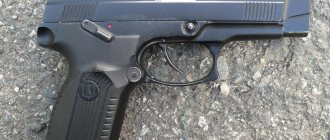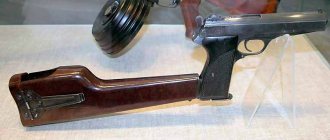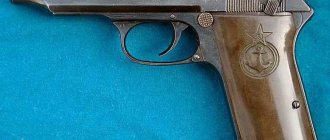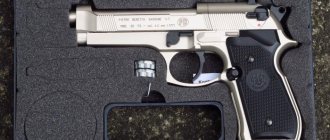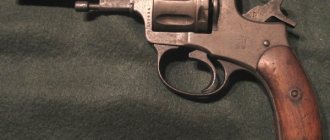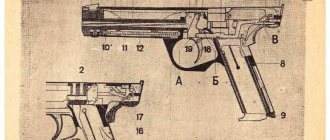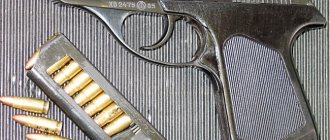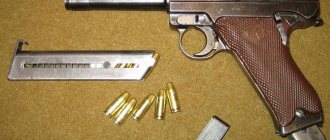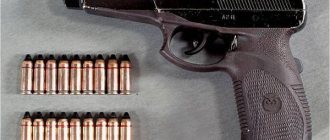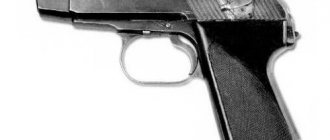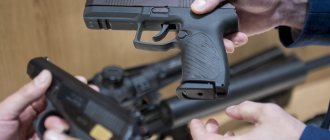The Gyurza pistol is one of the most powerful and most famous pistols in the history of the Russian Federation, created by Pyotr Ivanovich Serdyukov. Having a caliber of 9 millimeters, it is capable of not only hitting a person wearing a bulletproof vest, but also successfully penetrating the body of a lightly armored vehicle. It is called “Gyurza” or “Vector”, but in official documents it is listed as Serdyukov’s self-loading pistol. Initially, this pistol was ordered by the army, but it reached its greatest use in the special services, where it is highly valued not only for its lethality, but also for its large clip capacity and ergonomics.
Story
The history of the Serdyukov self-loading pistol (SPS) began with the development of a new pistol complex at the Klimov Research Institute. The pistol was supposed to surpass both domestic and foreign analogues in terms of service, operational and combat parameters. The need to create a new model of personal short-barreled weapon, radically different from those used in the army, special services and law enforcement agencies, arose back in the 80s. The reason for this is simple - the introduction into the armed forces of a number of countries of personal protective equipment that differs by class. Second-class body armor, for example, can stop a TT pistol bullet when fired at close range.
But not only law enforcement agencies, but also terrorist organizations began to actively use body armor. The body armor protects a maximum of 30% of the body. But in conditions of fire contact, everything begins and passes very quickly. Therefore, there is not enough time to aim, and fire is directed at the body, since this is the largest target. In this case, with body armor you can not only survive, but also actively return fire.
What was needed was a new weapon-cartridge complex that, having acceptable dimensions, low weight and low recoil, could effectively hit an enemy wearing body armor.
General information[edit]
The SPS pistol was developed in 1995 to replace the Stechkin pistol in the military. Like other weapons created under the “Rook” program, one of its features is the use of a cartridge with increased bullet penetration. In this indicator, “Gyurza” surpassed almost all competitors; during testing, its bullet with a lead core pierced a block of dry boards 18 cm thick from a distance of 10 meters; at a distance of 50 meters, penetration of class IIIA body armor or titanium armor plate up to 4 mm thick is guaranteed. Due to such a high destructive effect of the bullet, the main users of the Gyurza are assault special forces of law enforcement agencies - FSB, FSO; in the Armed Forces - special forces of the GRU, Airborne Forces.
New approach
The widespread use of personal protective equipment was not the only reason for the development of new weapons. The USSR's weapons system was built on the concepts of large-scale confrontation against NATO troops. Thus, the main focus was on missile and tank forces, aviation, artillery and large motorized infantry units. Personal weapons played one of the last roles. For example, the PM (Makarov pistol) was created as a peacetime weapon. But in combat, officers still took a machine gun. But in the conditions of partisan and local wars of the 70-80s, this approach to weapons turned out to be completely wrong.
Practice has shown that personal small arms play a huge role. Clashes in the above wars took place, as a rule, with the participation of small infantry units, which were supported by artillery, aircraft and tanks. Predominantly guerrilla methods of warfare were used, with a large number of surprise attacks from ambushes and shooting from short distances. As a result of this, there was a need to modernize personal short-barreled weapons.
Cartridges for SPS Serdyukov
Several types of ammunition have been developed for SPS:
- 7N28 (SP11) low-ricochet . Weighs 7.5 grams, bimetallic jacket, lead bullet with reduced ricochet potential. Best suited for use in urban areas with a large number of concrete and metal surfaces. Does not have color coding.
- 7N29 (SP10) armor-piercing . Equipped with a 6.74 gram bullet of increased armor penetration. Part of its heat-strengthened steel core in a polyethylene jacket extends beyond the boundaries of the shell. When a bullet hits a target, the core does not waste its energy to penetrate it. The top of the bullet is painted black. Boxes with such cartridges are also marked with a black stripe.
- 7BT3 (SP13) armor-piercing tracer . Bullet weight - 7.3 grams. Due to the presence of a tracer, it is used in low light conditions. The bullet is semi-jacketed. Consists of a steel core in a soft lead sheath. Marked in green.
For training, a training cartridge is used that outwardly completely corresponds to the SP-10, but there is no gunpowder charge and capsules.
All cartridges are packed in cardboard boxes of 30 pieces each.
Important! At arms factories, SP-10 UZ is used to test the strength of the contactor. Such ammunition is painted black before crimping the cartridge case. The boxes are marked with a warning message - “Increased charge”. The use of such ammunition outside of factory conditions is strictly prohibited.
Start of development
By the end of the 80s, the weapons industry received new materials. Changes began to be introduced into the design of pistols everywhere. The new generation pistol had to meet the following requirements: constant combat readiness, safety in handling, reliability in difficult operating conditions, great firepower, convenience and ease of operation and maintenance. Well, the cartridge used had to have a high stopping and penetrating effect of the bullet.
In 1991, the design team headed by Pyotr Serdyukov created two prototypes of a pistol with the index 6P35. In the meantime, B. Yuryev completed the development of a new cartridge RG052 with a high stopping and penetrating effect of the bullet. The cartridge had a caliber of 9 mm and a length of 21 mm. When developing the cartridge, it was assumed that it would be used not only in a pistol, but also in a submachine gun. The key feature of this cartridge is the structure of the bullet. The upper part of the core protrudes from the shell, which means less energy is needed to pierce it.
Serdyukov's pistol had an initial firing speed of 420 m/s. This was enough for the bullet to penetrate the body armor designed to stop assault rifle bullets. In 1993, a modernized version of the pistol was created, which received the index RG055 and the working name “Serdyukov pistol “Vector””. This model differed from the previous one in the shape and design of the bolt frame, the thickness of the barrel walls and the shape of the sight, which received enamel inserts. "Vector" was adopted by the security forces and troops of the USSR. A little later, Serdyukov’s SPS export pistol, “Gyurza,” appeared. This model is still used by the internal forces of a number of countries. Foreign models do not provide such a successful combination of characteristics as the Serdyukov pistol. “Gyurza,” like “Vector,” is not the official name of the weapon and does not appear in the documents.
From "Gyurza" to "Boa"
In December 1990, the Main Missile and Artillery Directorate of the Ministry of Defense (GRAU MO) of the USSR developed technical specifications for the creation of a new pistol to replace the reliable, but by that time insufficiently effective PM pistol. The theme of the development work was called “Rook”. It was assumed that the design of the new weapon would be modular and the use of several types of cartridges (7.62 mm TT, 9 mm PM and PMM) by replacing the barrel. The main requirement for the new pistol was to defeat manpower at a distance of 25 m wearing bulletproof vests of the Zh-81 and Zh-86-2 types.
The birth of "Gyurza"
Klimovsky TsNIITOCHMASH, as always, decided to follow a more difficult path, promising distant but long-term prospects. It is worth noting that even after almost twenty years, the potential of the solution proposed then is far from exhausted. By the beginning of the competition, the Tochmash team presented a completely new RG052 cartridge of 9x21 mm caliber and a PS pistol designed by P.I. Serdyukov. According to their calculations, it was the cartridge with an increased sleeve length that could fully satisfy the stated requirements of the GRAU. It should be noted that experiments with 9x21 mm cartridges in the USSR were carried out back in the 60s, but then this did not bring the expected results, and the bullet caliber corresponded to the 9x18 mm cartridge. This time the bullet caliber complied with Western standards for Luger cartridges, which made the cartridge only conditionally interchangeable with 9x19 mm cartridges. A bullet from such a cartridge will not get stuck in the barrel of a pistol chambered for a Luger cartridge, but the cartridge itself will not fit into the magazine. For example, the foreign cartridge 9x21 IMI, which also has a 21-mm sleeve, but the length of a “Luger” cartridge, allows you to shoot 9x19 mm pistols by replacing a new barrel with a different chamber.
1/2
Heading1
Heading2
Well-known American specialist in the field of modern small arms, Peter Kokalis, shoots from a Gyurza pistol. Catalog “Russian melee weapons”.
9-mm Serdyukov PS pistol and RG052 cartridge. trizna.ru
The Rook competition took place during a difficult period in the early 90s with its economic problems and lack of government funding. GRAU had to abandon the multi-caliber nature of the new pistol and begin developing weapons compatible with world standards for the world's most common 9x19 mm caliber cartridge. Under these conditions, the development of Serdyukov’s pistol lost state funding and switched to initiative tracks. This is how a pistol complex chambered for the 9×21-G cartridge appeared, where the letter meant the formidable name of the pistol —
"Gyurza."
“After all, a viper’s bite, like a shot from a new pistol, is fatal,” one
of the project leaders reasonably believed.
All this was done in the hope of finding the export potential of a pistol complex that would penetrate almost any body armor designed to protect against pistol bullets. There is information that the first batch of such pistols was sold to one of the rich Arab countries -
perhaps it was the export cash injection that allowed the “snake family” to survive in difficult times.
Pistol RG055 in gift version and cartridges for it. Magazine "MasterRuge".
The pistol, which received the RG055 index, had an automatic mechanism based on the recoil principle with a short barrel stroke. Locking the barrel, which moved along its axis during rollback, was carried out by a swinging lock. This design of automation and locking device was preserved in subsequent modifications of the pistol. The first pilot batch of 50 pistols was manufactured in 1993 and transferred for trial operation to special law enforcement units. The cartridge, which received the RG054 index, became more technologically advanced and suitable for mass production; the muzzle velocity of the bullet was slightly reduced. At a distance of 40 m, neither class 2 body armor nor the St.3 steel sheet 5 mm thick were an obstacle for him.
Who is the “Vector” from the FSB aimed at?
Soon the Russian Ministry of Security (the future FSB) became interested in the promising development. The rampant organized crime of the early 90s forced us to look for a solution that could counter it. The powerful complex chambered for the 9x21 mm cartridge came in handy. At the customer’s initiative, the Vector design and development work is opened, the pistol receives the CP1 index (special development), and the cartridge —
SP10 (special cartridge). The pistol complex is being modified to meet new requirements and undergoes a full cycle of state tests, as a result of which in 1996 a new powerful tool in the fight against crime and terrorism appears in the arsenal of the FSB.
9-mm CP1 pistol with 18 rounds of ammunition. roe.ru
Cartridge SP10 —
This is the RG054 cartridge modified to meet the requirements of mass production with optimized ballistic parameters (developed by L.S. Dvoryaninova). Subsequently, the range of ammunition for Vector expanded to include SP11 cartridges with a bullet with a lead core (developed by A.B. Yuryev, I.P. Kasyanov, E.S. Kornilova), SP12 with an expansive bullet (developed by M.I. Kabaev) and SP13 with an armor-piercing tracer bullet (developed by M.I. Kabaev, L.I. Novozhilova, T.P. Vasilyeva), developed for the Veresk submachine gun. The most interesting special tool in the special forces arsenal was the SP12 cartridge, which in stopping power is not inferior to the 10x25 mm Auto, the standard cartridge of the FBI.
"Granite" for the military
After the SR1 pistol was accepted into service by the FSB, the GRAU returned to interest in the pistol complex, and development work (R&D) for the Granit began in the interests of the Ministry of Defense. In December 1996, state tests of the pistol took place, which, due to its reliability under normal operating conditions and the service life of its parts (including the locking unit), did not meet the requirements of the technical specifications. The design of the magazine release lever was also noted. Refinement of the pistol, optimization of cartridge parameters, preparation of regulatory documentation and verification of the completeness of modifications continued until the end of 2000. On March 21, 2003, by Decree of the Government of the Russian Federation No. 166, the Serdyukov self-loading pistol was adopted into service by the RF Armed Forces (along with PYa pistols designed by V.A. Yarygin and GSh-18 designed by V.P. Gryazev and A.G. Shipunov). The pistol was assigned the index GRAU 6P53, and the SP10, SP11 and SP13 cartridges received the indexes 7N29, 7N28 and 7BT3, respectively.
With the 7N29 cartridge, the SPS pistol is capable of penetrating a 4-mm steel plate at a distance of 50 m. tass.ru
After modification, the pistol received a more conveniently shaped handle, a push-button magazine latch, an enlarged trigger guard for shooting with gloves, and sights with reflective capsules. The 7N29 cartridge retained its armor-piercing properties, the 7N28 had an R50 accuracy of no more than 2.6 cm at a distance of 25 m, and the 7BT3 could penetrate a 5 mm thick St.3 steel sheet at a distance of 55 m and gave a clearly visible path at a distance of up to 200 m.
9-mm SPS pistol produced by Kirov. twower.livejournal.com
SR1 and SPS pistols were mass-produced at the Kirov and Klimov TsNIITOCHMASH. You can distinguish such pistols by their emblem. —
for Klimovsk, “radical”
for
Kirov. Also a characteristic feature of Kirov pistols was the alphanumeric serial number, although TsNIITOCHMASH also used bolts manufactured at. Due to the lack of scarce light accumulators, SPS pistols could be supplied to the troops with standard CP1 sighting devices, but the Ministry of Defense never showed much interest in it, limiting itself to purchasing only a small batch for special forces units. After a short production period, the production of pistols was discontinued.
Further modernization of the complex
Taking into account the process of operating CP1 pistols and developments on the “Granite” topic, in 2000-2003, within the framework of the “Introduction” development work, work was carried out to improve the operational characteristics of the pistol. Like the SPS, the new pistol has a changed shape of the handle, a new push-button magazine release button has appeared, and the distance between the trigger and the front wall of the trigger guard has been increased for ease of operation with winter gloves. The main difference from the army pistol was the new wide rectangular rear safety button, as well as the sighting devices preserved from the CP1. The result of the development work was the adoption of a new modification into service by the FSB in 2004. —
SR.1M.
The attentive reader will notice the strange appearance of a dot in the pistol index. This is not a typo, but a whole story worthy of a separate article. For lovers of absolute accuracy, we will briefly explain the appearance of this punctuation mark. All documentation on R&D developed by TsNIITOCHMASH was carried under the index SR1M, but at some stage of the final execution of documents by the customer, the same unfortunate point from which the new pistol was accepted into service appeared in the index. The developer had no choice but to accept this unfortunate fact and correct his documentation by adding a handwritten point to the already printed documents. However, the chief designer of the pistol, P.I. Serdyukov turned out to be a pedant and was later able to ensure that the point disappeared from subsequent modifications of the pistol. Thus, it is quite acceptable to write the CP1M index both without a dot and with it.
A representative of TsNIITOCHMASH demonstrates the penetration ability of the SR1M. spezinform.ru
Since 2011, documentation for SPS and SR1M pistols has been unified. Thus, we can now put an equal sign between these two modifications, and the army pistol began to look exactly like a police pistol. It would not be amiss to give a brief and succinct description of the SR1M pistol from a representative of one of the special forces units of the Russian Guard, I. Carden:
“—powerful;
- accurate;
— very soft descent;
— during high-speed shooting, it rips out of your hands (throws you up);
— the front sight is a bit thin for high-speed shooting;
— the trigger is pressed against the frame, and self-cocking shooting is not very comfortable;
— for self-cocking to work, the hammer must first be slightly cocked;
- to fully cock the hammer, you need to hold the pistol with your right hand, turning off the key safety, and cock the hammer with the finger of your left hand;
“To pull the trigger smoothly, you also need two hands.”
Further modernization of the pistol took place in 2008-2010 as part of the “Elevation” R&D project. This is how a pistol with devices for attaching accessories appeared. A distinctive feature of the SR1MP is the presence of special removable devices with Picatinny rails and a muzzle muffler. The device is mounted in the pistol frame and allows you to install one or four rails for mounting a laser pointer, flashlight and collimator sight. The muzzle silencer is installed through a special bracket attached to the pistol frame. Serial production of SR1MP has been carried out since 2012 by FSUE TsNIITOCHMASH. The pistol’s arsenal was also replenished with new ammunition: the modernized SP11M and the reduced penetration SP17.
SR1MP pistol. TSNIITOCHMASH
In 2011, the FSB special forces adopted the SR1PM pistol with a set of technical equipment. The kit consists of a lightweight bolt and barrel, allowing you to fire 9x16 mm PMP cartridges with marking bullets. When firing standard cartridges, the pistol uses a set of three moving parts: the bolt casing, the cylinder and the barrel, which reduces the impact of recoil on the shooter’s hand. Pistol developed by P.I. Serdyukov and V.M. Kabaev in this version was very different from its predecessor and represented an original design.
At the Army-2019 exhibition, the SR1M pistol with the ability to fire 9x14 mm UP-M and UP-B training cartridges was demonstrated for the first time —
analogues of the world famous Canadian 9 mm FX® cartridges.
SR1PM pistol with educational and training cartridges. TSNIITOCHMASH
"Boa constrictor" of the snake family
After the successful modernization of pistols of the SR1 family, TsNIITOCHMASH began thinking about improving the army pistol. When the institute began work on the modernized SPS, a “boa constrictor” unexpectedly crawled into the “Gyurzov” family. The experience of recent local conflicts has proven the need for a powerful 9-mm pistol system, and the Ministry of Defense has again decided to return to development for the 9×21 mm cartridge —
this time a completely new promising system. In March 2014, the Boa Constrictor development work began, within the framework of which it was planned not only to develop a general-arms and special pistol, but also to create new ammunition for them.
Little is known about the new model yet. Due to the use of new polymer materials, the pistol weighs about 780 g, and with a silencer installed —
almost the same as a regular CP1M. The pistol frame is made of a new high-strength polymer material PA SV 40-1MUP, which has physical and mechanical properties that are 15-20% higher than other materials, and resistance to cyclic loads according to the main indicators is much higher. The new cartridges have a core similar to the SP16 cartridge of the PSS-2 pistol, which looks like a chisel. Cartridges with increased penetration can hit manpower in Br2-class body armor of the 6B23 type, but how much more powerful they have become in comparison with the 7N29 is unknown.
Shooting from a "Boa Constrictor" pistol. ria.ru
Having successfully passed state tests in December 2022, the pistol was recommended for mass production under the abbreviated name SP, and the documentation was assigned the letter O1. The pistol complex included a general-arms pistol, a special pistol with a silencer, cartridges with increased penetration 7N42 and with reduced bullet speed 7U4, and a laser target designator 1K242. At the Army 2019 forum, tactical and sporting pistols “Boa Constrictor” in 9x19 mm caliber were shown for the first time.
Tactical and sporting versions of the Boa Constrictor chambered for 9x19 mm. TSNIITOCHMASH
If the Boa Constrictor still has everything ahead, then the pistols of the CP1 family were able to give a start to life to the 9x21 mm caliber cartridge, still referred to in the West as 9mm Gyurza.
It was he who became one of the reasons for introducing changes in 2013 to the Russian GOST R 50744-95 on armor protection standards. Now a Br2 class body armor will save you from the 7N28 cartridge, and to protect against the 7N29 you already need Br3 class “armor.” The implementation of innovative solutions always encounters a lot of technological and economic difficulties. It seems that “Gyurza” and her descendants managed to overcome them and contribute to the emergence of a new generation in the family of Klimovsky, and now Podolsk “snakes”. Characteristics of pistols chambered for 9×21 mm
| Name | PS | THX | PSM | SR1MP | SR1PM | JV |
| Index | SR1 | 6P53 | SR.1M | SR1MP | SR1PM | 6P72 |
| OKR code | Vector | Granite | Application | Elevation | Vector-MB | Boa |
| Regular cartridge | SP10 | 7N29 | SP10 | SP10 | SP10/PMP | 7N42 |
| Weight with empty magazine, g | 920 | 900 | 900 | 1186 | 1000 / 820 | 780 / 980 |
| Length, mm | 200 | 205 | 200 | 210 / 404 | 200 | 206 |
| Height, mm | 145 | 148 | 148 | n/a | n/a | 145 |
| Width, mm | 34 | 34 | 34 | n/a | n/a | 36 |
| Magazine capacity, cartridges | 18 | 18 | 18 | 18 | 18 | 18 |
| Barrel length, mm | 120 | 120 | 120 | 130 | n/a | n/a |
| Sighting range, m | 100 | 100 | 100 | 100 | 100 / 25 | 100 |
| Initial bullet speed, m/s | 420 | 410 | 440 | 440 | 440 / 95 | n/a |
Sources and literature:
- Guide to the 9mm self-loading pistol SR1.000 DPE
- 9-mm modernized self-loading pistol. Operating manual SR1M.000 RE
- Serdyukov 9-mm self-loading pistol. Operating manual 6P53.000 RE
SR-1
In 1996, an improved model, called the “Serdyukov SR-1 pistol,” entered service with FSB units. The design had several changes. By updating the handle (several notches on the front and back sides, as well as corrugation on the sides), it has become more comfortable, which is important given the rather powerful recoil of the weapon. The dimensions of the pistol have increased slightly, and along with them the service life of the parts has also increased. The bore began to be chrome-plated. The cartridge was also modified. Together with a 6.74-gram cartridge, the pistol gave 410 m/s initial bullet speed and 565 J of energy. A second-class body armor could be hit from a distance of up to 70 meters. Several new cartridges were also created with hollow-core, armor-piercing tracer bullets, as well as lead-core bullets.
Ammunition[edit]
The Serdyukov pistol uses a high-power 9x21 mm cartridge; this is the most powerful pistol cartridge in Russia and one of the most powerful in the world. There are four varieties of this cartridge:
- SP10 - with an armor-piercing bullet weighing 6.7 grams (with a heat-strengthened core, the head part of which protrudes from the shell, a polyethylene jacket and a bimetallic shell);
- SP11 - with a low-ricochet bullet weighing 7.5 grams (lead core, bimetallic shell; a low-ricochet bullet is necessary when conducting combat, for example, in urban conditions);
- SP12 - with an expansive bullet weighing 5.7 grams, designed for non-lethal destruction of the enemy and also when shooting in enclosed spaces.
- SP13 - with an armor-piercing tracer bullet weighing 7.3 grams (with a shortened steel core, lead jacket, tracer composition and bimetallic shell).
The same cartridge is used in the SR-2 “Veresk” submachine gun.
Design Features
The Serdyukov SR-1 pistol received a barrel bore locking system using the so-called swinging cylinder. This had a positive effect on shooting accuracy. The return spring is located around the barrel and rests against a special stop. For ease of disassembly, the frame consists of two parts. The handle and trigger guard are made of impact-resistant plastic. The metal (top) part includes a number of parts and has guides for the bolt frame. The double-action trigger mechanism has a safety cocking guard, but it is not automatically installed on it.
Gyurza and Vector pistols - export samples
The improved pistol was adopted by various special forces of the FSB, the Ministry of Internal Affairs and internal troops. These guns are still in use. Then a version for export appeared: model 055С GYURZA. It should be noted that the names “Gyurza” and “Vector” are unofficial and do not appear in decisions on the adoption of one or another version of the weapon for service. The cartridge, designated RG054, was also modified. In 1996, the FSB special forces adopted an improved Serdyukov pistol with the name SR.1 (SR is an abbreviation for special development) and a 9x21 cartridge with the designation SP.10. Some changes have been made to the design of the gun.
SP.10 cartridge (right) versus 9mm Parabellum
Due to some changes in shape, the handle has become more comfortable. Large horizontal notches on the front and rear surfaces, diamond-shaped notches on the sides and notches on the upper rear of the grip increase control of the weapon when handling, aiming and shooting. The dimensions have increased slightly, but at the same time the reliability of operation and the service life of parts have increased. The hole is now chrome plated. The export change was named RG060. The SP.10 cartridge with a bullet weighing 6.74 g, with a steel core, an initial speed of 410 m/s and a muzzle energy of 566 J is designed to defeat enemy personnel protected by personal protective equipment consisting of a reinforced steel core, a polyethylene coating and a bimetallic shell . Penetration of second class armor is ensured at a range of up to 70 meters. New cartridges have been created: SP.11 with a bullet with a lead core (bullet weight 7.9 g, initial speed 390 m/s); SP.12 with an expanding bullet; SP.13 with an armor-piercing tracer bullet.
For the new pistol, a barrel bore locking system was chosen using a swinging cylinder, which, due to the movement of the barrel along its axis, guarantees high shooting accuracy. The return spring is located around the barrel and rests on a special part: the return spring stop. The frame consists of two main parts. The bridge handle is made of impact-resistant plastic. The upper metal part connects to several parts of the pistol and is equipped with guides for moving the bolt housing. The trigger mechanism is a double-action hammer with safety cocking, but the hammer is not automatically engaged. To fire a self-cocking shot, you must first install the trigger on the safety. To manually cock the hammer, the automatic locking safety must be disabled. If a misfire occurs during a shot, it is corrected in a much more reliable way than with a new primer, by sending a new cartridge into the chamber.
The pistol has two automatic safeties. The automatic handle safety switch (lever), located on the rear surface of the handle, goes out. An automatic safety device protrudes on its front surface, which blocks movement until the arrow is pressed with a finger. When all the rounds are expended, the bolt carriage stops the bolt (i.e. the bolt latch, not the bolt), and when a loaded magazine is connected, it automatically ejects and fires a round into the chamber. Due to the lack of a slide stop lever found on most modern combat pistols, manually moving the slide to the forward position requires pulling it back slightly and manually releasing it.
Partial disassembly of the SR-1 pistol
The ambidextrous magazine release is located on the top front of the handle behind the crossbar. The box magazine holds 18 rounds with a double-stack arrangement and a double-stack output. The sights consist of a front and rear sight with vertical white stripes for easy aiming in low light conditions. Transverse adjustment can be made by moving the rear sight fixed in the dovetail groove using a special device included in the spare parts kit. Disassembly of the weapon is carried out by turning the barrel bolt located on the right side of the frame. Many design and technological solutions are protected by invention patents.
In 1997, by order of the Ministry of Defense, tests of the SR.1 were carried out in order to assess the possibility of adopting a new pistol and cartridges. Changes have been made to the design again. The handle has a different shape. There is only a large horizontal notch on its surface at the front and back. The new shape is more versatile and makes the firearm almost as comfortable to use for shooters of different body types. The magazine release has become a button. The size of the sights has been increased, the shape of which has changed. In December of the same year, state tests were completed, and the gun itself was classified as “not meeting reliability requirements,” after which this weapon stopped participating in the Rook competition and began to develop independently. Work on further modifications and testing was called “Granit” and was carried out until 2000, after which the gun again changed its name to SR-1M “Vector”. At that time, he entered the regional special forces of the FSB of the Russian Federation and some detachments of SOBR and WHO of the Ministry of Internal Affairs for trial operations.
The improved pistol received the name SPS (Serdyukov self-loading pistol) and was adopted by the FSB by Decree of the Government of the Russian Federation of May 29, 2010 No. 166 of March 21, 2003. The Serdyukov pistol index is 6P53. The new pistol has a more comfortable grip, a larger trigger guard, redesigned sights and a push-button magazine release located on the left grip, at the base of the trigger guard. The names of the cartridges have been changed again: 7N29 with an armor-piercing bullet with a steel core; 7N28 with lead core; 7BT3 with an armor-piercing tracer bullet. However, the same 7N29 cartridges are no different from SP.10 and 7N28 from SP.11. The only difference is in the customer; the manufacturer puts the SP index on the sleeves for FSB, and 7N for BC.
SR.1 pistol produced by TsNIITOCHMASH and 7N29 cartridges
The production of the Serdyukov SPS pistol has been established at TsNIITOCHMASH and OJSC Kirov Plant Mayak. The manufacturer's markings are applied to the side surfaces of the handles. Guns produced by TsNIITOCHMASH have a stylized owl's head. The weapon bears a radically stylized mathematical symbol. It should be clarified that the designations SR.1M and SPS are used in parallel, the first by the FSB, the second by the Ministry of Defense. Technical differences between the SR.1M and the SPS are an enlarged key (at the request of FSB and FSO employees) for the automatic grip safety, a change in the configuration of the sights and a lower ejector weight.
In August 2012, the Central Research Institute of Precision Engineering presented the following modification of the SPS pistol with the designation SR1MP, which is distinguished by the presence of grooves on the sides of the front part of the frame, to which a block with grooves can be attached; a Picatinny rail is attached for installing various collimators, laser designators and tactical flashlights . A shot silencer can be connected to the SR1MP pistol. In addition, the key to automatic capture security has been increased. In general, the Serdyukov pistol has excellent combat and service characteristics, confirmed when used in real combat operations. The weapon works perfectly in extreme operating conditions and at temperatures from -50 ° C to + 50 ° C. The sighting range of 100 meters has been confirmed in practice. The accuracy of combat (average shooter) when firing a series of ten shots at a distance of 25 meters is 6.5 cm, and at a distance of 100 meters - 32 cm. At a distance of 100 meters when shooting from a joint venture. 10 rounds, armor plates containing up to two 1.4 mm thick titanium plates and 30 layers of Kevlar, or steel sheets up to 4 mm thick.
The gun has high quality manufacturing and surface treatment. The handle is very comfortable, but the safety key of the automatic handle, due to a fairly powerful spring, puts a lot of pressure on the shooter’s palm. Due to the rather large volume of the grip, shooters with small hands have to change the “grip” when changing magazines. In practice, the front protrusion of the bridge turned out to be completely useless and useless, since, first of all, to reduce the launch when firing, the method of holding the index finger of the hand supporting the weapon on the protrusion of the trigger guard is absolutely ineffective, and secondly, even for shooters with average With the palm of your hand, it is impossible for the finger on this protrusion to be normal.
Pistol SR.1M produced by TsNIITOCHMASH
The SR1MP pistol is the latest version of the Serdyukov pistol with an open collimator and a silent, flameless firing device mounted on the weapon through a lock with a Picatinny slot
The strange configuration of the trigger makes it very difficult to fire a self-cocking shot when quickly drawing the weapon, since the arrow index pad in most cases rests on the tip of the trigger and does not rest on its bend, after which it slides on the front surface of the trigger, with painful sensations for the shooter... The safety button of the automatic trigger does not give any unpleasant sensations, does not press or rub your finger even during prolonged shooting. However, despite all the shortcomings, the Serdyukov pistol is in production and continues to be used by various law enforcement and other “security” agencies of the Russian Federation. Currently, the Serdyukov pistol is in service with special forces of the FSB, FSO, some SOBR and WHO Ministry of Internal Affairs detachments, in limited quantities it is available in the Presidential Security Service (SPB), border troops, etc. It is used in other law enforcement agencies, both in Russia and in other countries. countries.
Various reviews from people who have experience handling and shooting the ATP pistol: “The pistol is quite large, but has excellent grip ergonomics considering the length of the cartridge. “Soft” and effective work. The trigger travel is very smooth, but at the same time its force in single action mode is small. Excellent shooting accuracy. This pistol generally does not have any protruding parts on the sides, making it easy to carry. The pistol is perfectly balanced, the handle fits comfortably in the hand. It is very durable and can withstand high loads both when used in the most difficult conditions and when firing powerful cartridges. The weapon is durable and has a long service life.
The pistol's downside is the lack of a slide stop lever and the need to manually move the slide back slightly to fire a round from a loaded, attached magazine. During extended shooting practice, the automatic safety lever at the rear of the grip presses against the palm and the trigger safety presses against the finger. It is impossible to cock the trigger for an accurate shot with the thumb of the shooting hand while holding the pistol with one hand - this will prevent the automatic safety from doing so, which will no longer be squeezed by the palm. This pistol, of course, is not without its shortcomings, but the ability to quickly and reliably hit an enemy wearing a bulletproof vest, reliability, shooting accuracy and a solid supply of ammunition in the magazine outweigh its shortcomings. A powerful weapon for real combat conditions. Great and nice car."
Pistol SR.1M Photo (c) KardeN
Features, materials, performance characteristics
"Gyurza" has the following technical characteristics:
- Weight without a loaded magazine - 900 g, with a magazine - 1200;
- Barrel length - 120 mm, and the entire product - 200 mm, width - 34, height - 145 mm;
- The cartridges used are 9x21 mm. There are several types. About them below;
- Caliber - 9 mm;
- Rate of fire - 40 v/m;
- The store has 18 items;
- Initial bullet speed 410 meters per second
The most modern materials are used in production. In particular, the handle is made of polymers, reducing the weight of the entire device.
The changes made to the special services order include, in addition to reducing weight and improving grip, the aiming system has been redesigned.
The addition of white varnish improved the ability to aim in low light conditions.
There are several types of SPS ammunition:
- 7N28 (SP11) - weighs 7.5 grams, has a lead filling, and is packaged in a special package that reduces the likelihood of rebound. Used in urban combat conditions, with a large number of concrete and metal surfaces;
- 7N29 (SP10) - weighs almost 8 grams, a bullet with increased armor penetration. This is achieved due to a specific design: part of the hardened steel core protrudes beyond the casing, which allows you to avoid wasting energy during its penetration;
- 7BT3 (SP13) - 7.3 grams, convenient for combat in low light conditions. Its design contains a tracer compound, a soft lead shell and a steel core. This gives the ammunition impressive stopping power.
Automation uses recoil energy with a short stroke of the barrel itself. A similar system is used in the Beretta 92 and Walter P38. After the shot the barrel returns. To bring it back, a spring was added to the structure that wrapped around it. This is the first time this pattern has been used in a short barrel with an unfastened barrel.
This arrangement of the return spring also made it possible to reduce the size of the casing. When fired, the return spring is compressed and when a new cartridge is inserted into the barrel, it returns it to its place.
The trigger is released after the trigger is pressed. In preparation for the first shot, the trigger must be cocked, or this is done by automatic loading when loading a new magazine.
To protect against accidental fire, there are 2 fuses that do not need to be “removed” or “inserted”.
Everything happens automatically. One is located on the back of the grip and is turned off and “removed” when the shooter grabs it firmly with his hand. The other is right on the trigger. The second one is made in the form of a button and turns off when you press it with your finger.
After firing loaded ammunition, the bolt is retracted and remains in this position until the magazine is replaced. You can also return it manually. In the event of a misfire, the bolt simply contracts and the jammed ammunition flies away. Instead, the next one gets up. The sleeves are brought forward through a special channel and slightly to the right.
Characteristics and Features
For shooting, you can use both regular and armor-piercing cartridges.
This pistol has the following features:
- The weight of the product with the charger is 1.2 kg, without it - 0.9 kg.
- Special cartridges measuring 21x9 mm are used.
- Barrel length - 120 mm, caliber - 9 mm.
- Rate of fire parameters: up to 40 rounds per minute.
- The magazine contains 18 rounds.
- The initial bullet speed is 410 m/s.
The Vector (Gyurza) pistol is made of the most modern materials, which are used to improve the technical characteristics of this weapon. In particular, the polymer handle significantly reduces the weight of the pistol.
Those modifications of the pistol that were carried out on a special order from the special services require a serious reworking of the aiming system. This is necessary to improve the ability to aim in low light conditions.
Let's look at the ammunition options used in these guns:
- SP10. Armor-piercing bullet weighing approximately 8 grams. It is distinguished by an unusual design, in which part of the active zone is removed from the outside of the housing. This is necessary so as not to waste extra energy on breaking through the core when hitting the target.
- SP11. Bullet weight 7.5 grams. It is filled with lead and made to minimize the chance of kickback. Most often used in urban environments, where concrete and metal surfaces predominate.
- SP13. A bullet weighing only 7.3 grams is the optimal solution for combat in low light conditions. The design assumes the presence of a tracer, a steel core and a lead sheath. Such materials provide high stopping power of this ammunition.
Precaution
To fire a self-cocking shot, you must first put the safety arm on the safety cock. To cock the shackle manually, it is imperative to turn off the automatic handle safety. If a misfire occurs during shooting, it is eliminated by chambering a new cartridge, and not by re-piercing the primer, as was previously the case.
Great power requires special care. Therefore, the pistol has two automatic safeties. The handle safety, also known as the lever safety, is located on the back of the handle, locking the sear. The second fuse protrudes from the surface of the trigger and blocks its movement until the trigger is pressed by the shooter.
Self-loading
When all the cartridges from the magazine are expended, the bolt casing automatically goes to the shutter stop (not a delay, but a stop). When the new magazine is in place, the bolt casing is automatically released and forces a cartridge into the chamber. Thus, by attaching a loaded magazine, the shooter can immediately begin firing without reloading the weapon. There is no need to pull the bolt back (which takes up valuable time) as on most pistols.
OTs-27 "Berdysh"
Developed in the 90s of the last century for units of the Ministry of Internal Affairs, under the leadership of I.Ya. Stechkin and B.V. Avraamov, at the Tula Design Bureau. A noteworthy feature is that the pistol allows for a quick transition from one type of ammunition to another by changing the barrel and magazine. Thus, it is possible to fire calibers 7.62x25 TT, 9x18 PM and PMM and Parabellum 9x19. The target firing range is 50 meters.
OTs-27 "Berdysh"
Due to the relatively weak penetrating ability of the specified ammunition, but good stopping properties, the OTs-27 was not of interest to the Ministry of Defense, but for the needs of the Ministry of Internal Affairs it turned out to be very useful. With increased ammunition compared to the PM, 15 (9 mm) or 18 (7.62 mm) cartridges, reliable and simple, convenient when shooting with both the right and left hands, and for convenience when shooting with both hands - with with a transverse notch in the front part of the trigger guard, the “Berdysh” fell into favor with law enforcement officers. For safety reasons, the pistol is equipped with an indicator of the presence of a cartridge in the chamber.
A few more features
The Serdyukov pistol has a double-sided sliding magazine latch. It is located in a standard place - at the top of the store, behind the descent. Due to the fact that the latch is located on both sides, the pistol can be used with equal convenience by both right-handed and left-handed people. The magazine has a box-like structure and holds as many as 18 rounds. This feature, along with the self-loading nature of the pistol, is its main advantage. Accurate shooting is ensured thanks to the front sight and rear sight, on which light stripes are painted for accurate fire at dusk. If necessary, the rear sight can be adjusted using special tools included in the spare parts kit. Disassembly of the gun is carried out according to the standard procedure.
Changes 1997-2003
In 1997, the Serdyukov pistol again underwent design changes. The handle has acquired a new shape, which makes it possible for shooters of different body types to hold the pistol equally comfortably. The magazine received a push-button latch. And the sighting devices acquired slightly different dimensions and shape. At the end of the same year, the pistol was unable to win the Rook competition and began to develop independently. Work to fine-tune the model to new requirements was called “Granite” and continued until 2000. As a result, the pistol again changed its name to “Vector SR-1M” and entered some special service units for testing.
In 2003, Serdyukov’s pistol was adopted by the FSB, but after further modifications. The handle has become more comfortable and the trigger guard has been enlarged. Now the model has become known as SPS, which means “Serdyukov self-loading pistol.” However, it was self-loading before. In general, the military calls this model differently: “Serdyukov pistol”, “SPS”, “SR-1”, “Vector”, “Gyurza”, despite the fact that each of the names was given to the weapon in different years.
Pistol SR1M Gyurza cartridge caliber 9 mm. Device
Self-loading Serdyukov Pistol (SPS, Index GRAU 6P53) - a pistol developed for special-purpose power units, according to the R&D program "Grach" by TsNIITochmash designers P. I. Serdyukov and I. V. Belyaev chambered for a cartridge of increased efficiency 9 × 21 mm mod. 1995 (designation TsNIITochmash RG054) with a muzzle energy of a bullet of 635 J.
Advantages
In general, Serdyukov’s self-loading pistol has excellent operational and combat characteristics. Its reliability has been confirmed by participants in real combat operations. The model operates reliably in the temperature range from -50 to +50 °C. At the same time, thanks to the plastic handle, you can comfortably hold it with your bare hand in any weather conditions. The trigger safety key does not interfere with comfortable shooting at all. The Serdyukov pistol has a high quality of assembly, processing of materials and their manufacturing. The high-strength plastic used in the design performed excellently.
Flaws
Due to the powerful spring, the handle safety puts quite a lot of pressure on the hand. Due to the large handle, those with small hands have to change their grip when changing magazines. The strange shape of the trigger makes it difficult to quickly fire a self-cocking weapon when drawing the weapon. The fact is that, as a rule, the shooter’s finger rests on the edge of the trigger guard, and not on its center, which leads to the finger slipping.
Despite these shortcomings, the Serdyukov self-loading pistol is actively produced and used by various law enforcement and security agencies of the Russian Federation. It is in service with units of the FSB, FSO, individual SOBR and OMSN units. The presidential security service and border troops also have weapons.
Options and modifications
- RG055
pistol is a pre-production version; during 1996, several pilot batches were manufactured, totaling about 2000 pieces. The bolt is rounded, the trigger guard is rounded, the pistol grip is made of rough dark gray plastic. - pistol "Gyurza"
(RG055S) - export version of the pistol
RG055
. It is distinguished by careful external finishing with the image of a snake on the side surface of the bolt. - SR1
pistol - mass-produced from December 1996 to 2000 for the FSO and FSB. Can use special ammunition. Shutter with longitudinal edges. The trigger guard has a modified shape, with a protrusion for the finger of the second hand. There is a marking on the handle - the trademark of the manufacturer (for TsNIITochMash - a stylized owl’s head inscribed in a circle; y - a stylized mathematical symbol “radical” inscribed in a circle). - pistol "Gyurza"
(RG060) - export version of the
SR1
. - SPS
pistol - mass-produced since 2000 for special forces of the Ministry of Defense and SVR. It is distinguished by a modified pistol grip shape. Push-button magazine release located on the right side, instead of the double-sided one on the SR-1. The rear sight shape has been changed. Currently not produced. - SR1M pistol - mass-produced for the FSO and FSB since 2003. Used with various types of ammunition, including hollow point bullets. Handle with enlarged safety button. Push-button magazine release and frame like SPS. Sights have been changed. After replacing the magazine, the bolt is automatically removed from the slide stop.
SR1MP
the SR1MP pistol is the latest modification, characterized by the presence of grooves on the sides of the front part of the frame, to which a Picatinny rail can be attached for installing various additional devices on the weapon: collimator sights, laser target designators (LTD) and combat (tactical) flashlights. It is possible to install a silencer on the SR1MP pistol for quiet shooting.
Serdyukov pistol: technical characteristics
Practice has shown that the target firing range of this type of weapon is 100 meters. The accuracy of the battle deserves praise. A fighter with an average level of training at a distance of 25 meters places ten bullets in an area with a diameter of 6.5 cm. At a distance of 100 meters, the figure increases to 32 cm.
A shot from a hundred meters with an SP-10 cartridge pierces a body armor consisting of two titanium plates 1.4 mm thick, as well as 30 layers of Kevlar.
As a summary, let us recall the main characteristics of the SPS pistol. The length of the pistol is 200 mm, and the barrel length is 120 mm. The height of the weapon is 145 mm, and the width is 34 mm. Caliber – 9 by 21. Weight of the pistol without cartridges – 900 g. The magazine holds 18 rounds.
Photo of the SR1MP pistol
SR1MP pistol with Picatinny rail, red dot sight and silencer
Similar
AK-47 assault rifle cartridge caliber 7.62 mm.
Device. Rate of fire AK-74 assault rifle cartridge 5.45 mm caliber. Device. Rate of fire
Dragunov SVD sniper rifle caliber 7.62 mm. Device
AKS-74U assault rifle cartridge caliber 5.45 mm. Device. Weight
Mauser K96 pistol cartridge caliber 7.63 and 9 mm. Device
Pistol Walter PP / PPK cartridge caliber 7.65 and 9 mm. Device
Pistol Yarygin PYa Grach cartridge caliber 9 mm. Device
DShK machine gun cartridge caliber 12.7 mm. Device. Rate of fire
Luger pistol R.08 Parabellum cartridge caliber 9 mm. Device
Pistol PM cartridge caliber 9 mm. Rate of fire. Dimensions. Bullet speed. Sighting range
Self-loading shotgun Saiga-12 cartridge, caliber. Device
Maxim machine gun cartridge caliber 7.62 mm. Device. Weight
PPSh-41 Shpagina submachine gun cartridge caliber 7.62 mm
APS Stechkin pistol cartridge caliber 9 mm. Device
Nagan system revolver cartridge caliber 7.62 mm. Device
Kalashnikov PK machine gun and PKM cartridge caliber 7.62 mm. Device
Simonov carbine SKS-45 cartridge caliber 7.62 mm. Device
Rifles and carbines Mauser 98 caliber 7.92 mm. Device
PPS-42 and PPS-43 Sudaev submachine gun cartridge caliber 7.62 mm
Pistol Walter P38 cartridge caliber 9 mm. Device
MP-40 German submachine gun cartridge caliber 9 mm. Device
VSS Vintorez sniper rifle caliber 9 mm. Device
Submachine gun PP-91 Kedr cartridge 9 mm caliber. Device
Light machine gun RPK-74 cartridge caliber 5.45 mm. Device
Pistol Glock 17 cartridge caliber 9 mm. Device
Makarych, Izh-79-9T, MR-79-9TM, MP-80-13T traumatic pistol
AK-12 assault rifle cartridge caliber 5.45 mm. Device. Weight
Mosin rifles and carbines Three-line caliber 7.62 mm
PMM Makarov pistol modernized 12 rounds. Device
Revolver Colt Single Action Army (SAA) Peacemaker. Device
Machine gun PKP Pecheneg cartridge caliber 7.62 mm. Device
Sniper rifle VSSK Exhaust caliber 12.7 mm. Device
Beretta pistol 92 cartridge caliber 9 mm. Device
TT - Tokarev pistol cartridge caliber 7.62 mm. Device
Submachine gun PP-19 Bison cartridge caliber 9 and 7.62 mm. Device
Sniper rifle SV-98 caliber 7.62 mm. Device
Vladimirov KPV machine gun cartridge caliber 14.5 mm. Device
ASH-12 assault rifle cartridge caliber 12.7 mm. Device. Rate of fire
PSM pistol cartridge caliber 5.45 mm. Device
Pistol Colt M1911A1 cartridge caliber 45. Device
Smith-Wesson revolver Russian cartridge, caliber 10.67 mm. Device
Degtyarev DP-27 light machine gun, 7.62 mm caliber cartridge. Device
Shotgun Mossberg 500 Cartridge. Dimensions. Rate of fire. Sighting range
Pistol USP Heckler und Koch cartridge, caliber. Device
Thompson submachine gun cartridge caliber 11.43 mm. Device
Hunting carbine OSK-88 (SVT-40) caliber 7.62 mm. Device
AS Val silent automatic cartridge caliber 9 mm. Device
Submachine gun PP-19-01 Vityaz cartridge 9 mm caliber. Device
Machine gun Kord cartridge caliber 12.7 mm. Device. Weight. Sighting range
Osa - traumatic pistol cartridge, caliber. Device
AK-9 assault rifle cartridge caliber 9 mm. Device. Rate of fire
Degtyarev RPD light machine gun, 7.62 mm caliber cartridge. Device
Automatic OTs-14 Groza cartridge caliber 9 mm and 7.62 mm. Device
Czech pistol CZ-75 (modifications). Device
Browning pistol 1903 cartridge caliber 9 mm. Device
Sniper rifle OSV-96 caliber 12.7 mm. Device
FN P90 submachine gun cartridge caliber 5.7 mm. Device
Submachine gun OTs-02 Cypress cartridge caliber 9 mm. Device
Sniper rifle ASVK Kord caliber 12.7 mm. Device
Automatic AEK-971 Cartridge. Caliber. Device. Rate of fire
Steyr AUG assault rifle (A1, A2, A3) cartridge caliber 5.56 mm
AK series 100 assault rifles. Modifications. Device. Weight. Dimensions
Uzi submachine gun. Cartridge. Caliber. Rate of fire
Pistol SR1M Gyurza cartridge caliber 9 mm. Device
Pistol GSh-18 cartridge caliber 9 mm. Device
SVDK sniper rifle caliber 9.3 mm. Device
Automatic SR-3M Whirlwind cartridge caliber 9 mm. Device
Machine gun NSV-12.7 Utes cartridge, cal. Device. Weight
Kalashnikov RPK light machine gun cartridge caliber 7.62 mm. Device
Sniper rifle VSK-94 caliber 9 mm. Device
Vostok-1 (Jorge-3M) 9mm caliber traumatic pistol. Device
Degtyarev PPD submachine gun cartridge caliber 7.62 mm
English sniper rifle L96A1 cartridge, caliber
M1 Garand rifle cartridge caliber 7.62 mm. Device
Desert Eagle pistol. Device
Smith-Wesson revolver (modifications). Device
Automatic rifle HK G36 (E, K, C, KE) cartridge caliber 5.56 mm
Pistol P-96 cartridge caliber 9 mm. Device. Rate of fire
Pistol GP35 Browning High Power cartridge, caliber. Device
Assault rifle FN SCAR (L, H) cartridge caliber 5.56 and 7.62 mm
Revolver Lefoshe M1856 cartridge caliber 11 mm. Device
Submachine gun PP-90 cartridge caliber 9 mm. Device
AN-94 Abakan automatic Nikonov cartridge caliber 5.45 mm. Device
Submachine gun PP-2000 cartridge caliber 9 mm. Device
Mauser pistol HSc cartridge caliber 7.65 and 9 mm. Device
M16 automatic rifle cartridge caliber 5.56 mm. Device
Fedorov assault rifle cartridge caliber 6.5 mm. Device. Rate of fire
Pistol Baltiets cartridge caliber 7.62 mm. Device
Strizh pistol cartridge caliber 9 mm. Device. Weight. Sighting range
Browning pistol 1910 cartridge caliber 7.65 and 9 mm
Silent pistol PSS Vul cartridge caliber 7.62 mm. Device
Pistol SIG-Sauer P226 cartridge caliber 9 mm. Device
Pistol OTs-27 Berdysh cartridge caliber 7.62 mm and 9 mm. Device
AK-107 assault rifle cartridge caliber 5.45 mm. Device. Rate of fire
OTs-44 sniper rifle, caliber 12.7 mm. Device
German machine gun MG3 cartridge caliber 7.62 mm. Device
Self-loading shotgun Browning Auto-5 cartridge, caliber. Device
Submachine gun AEK-919K Kashtan cartridge caliber 9 mm. Device
PB pistol silent cartridge 9 mm caliber. Device
Pistol OTs-33 Pernach cartridge caliber 9 mm. Device
Hunting carbine KO-98 cartridge caliber 7.92 mm. Device
TK (Korovin pistol) caliber 6.35 mm. Device. Weight. Dimensions
Underwater assault rifle APS cartridge caliber 5.66 mm. Device
Pistol OTs-21 Malysh cartridge caliber 9 mm. Device
American M60 machine gun, 7.62 mm caliber cartridge. Device
MTs-116M sniper rifle, caliber 7.62 mm. Device
Automatic 9A-91 cartridge caliber 9 mm. Device. Rate of fire
Submachine gun PP-93 cartridge caliber 9 mm. Device
VAG-73 - Gerasimenko pistol. Device. Weight. Dimensions
Cordon-5 is a traumatic pistol. Device. Weight. Dimensions
Goryunov SG-43 heavy machine gun cartridge caliber 7.62 mm. Device
Webley revolver cartridge, caliber. Device. Dimensions. Weight
Machine gun AEK-999 Badger cartridge caliber 7.62 mm. Device
RP-46 machine gun, 7.62 mm caliber cartridge. Device. Rate of fire
Sniper rifle VS-8 cartridge caliber 8.6 mm. Device
Slostin machine gun cartridge caliber 7.62 mm and 14.5 mm. Device
Assault rifle Tavor TAR-21 cartridge caliber 5.56 and 5.45 mm
Submachine gun SR-2 Veresk cartridge caliber 9 mm. Device
Lancaster pistol cartridge caliber 12.1 mm. Device. Rate of fire
Submachine gun PP-90M1 cartridge caliber 9 mm. Device
Underwater pistol SPP-1M. Device. Weight. Dimensions
Traumatic pistol MP-461 Guard. Device. Weight. Dimensions
Lebel rifles and carbines are cartridgeed in 8 mm caliber. Device
Automatic A-91 cartridge caliber 7.62 mm. Device. Rate of fire
M14 automatic rifle cartridge caliber 7.62 mm. Device
Revolver Smith & Wesson Model 10 Military & Police
Automatic rifle FN FAL cartridge caliber 7.62 mm. Device
Submachine gun STEN MK 2. Device. Weight. Dimensions
Traumatic pistol IZH-78-9T Chain mail cartridge caliber 9 mm
Leader-M traumatic pistol 11.43×32T. Device. Weight. Dimensions
Ingram M10 and M11 submachine gun. Device. Weight. Dimensions
Pistol Steyr M9-A1 cartridge caliber 9 mm. Device. Weight
Pistol OTs-23 Dart cartridge caliber 5.45 mm. Device
Berthier rifles and carbines caliber 8 mm. Device
Automatic shotgun USAS-12 cartridge caliber 18.5 mm
Sniper rifle VS-121 caliber 7.62 mm. Device
Traumatic pistol MP-353 cartridge, caliber 11.43 mm
Tiss machine gun cartridge caliber 9 mm. Device. Rate of fire
Traumatic pistol MP-355 cartridge caliber 9 mm. Device
Automatic double-medium ADS cartridge caliber 5.45 mm. Device. Rate of fire
Traumatic pistol MP-81 cartridge caliber 9 mm. Device
Pistols Zastava 70 and 70(k), cartridge caliber 7.65 or 9 mm. Yugoslavia
Sniper rifle GALATZ (Galil) cartridge caliber 7.62 mm
Pistol MP-444 Bagheera cartridge caliber 9 mm. Device
Revolver Colt New Army / Navy. Device. Bullet speed. Sighting range
Type 64 is a Japanese automatic rifle. Device
Comments
0 samuryrsteam 01/29/2017 17:55 That is, if I shot all the cartridges, the SR-1 is on the slide stop, and I just need to put it in my pocket without sending the cartridge into the barrel, then it turns out I don’t have a button on it, which I would just return the frame to its normal position, and then insert the magazine with cartridges and put it in my pocket. It turns out that you either have to carry it constantly with a cartridge in the barrel, or))))) insert an empty magazine so that the automation would remove it from the slide stop, but the gun was not loaded at the same time)))) Or is there a button like that?!
Reply | Reply with quote | Quote
0 mihael toptygin 01/29/2017 17:55 I quote samuryrsteam:
That is, it turns out that if I shot all the cartridges, the SR-1 is on the slide stop, and I just need to put it in my pocket without sending a cartridge into the barrel, then it turns out that I don’t have a button on it to simply return the frame to its normal position, and then insert the magazine with cartridges and put it in your pocket. It turns out that you either have to carry it constantly with a cartridge in the barrel, or))))) insert an empty magazine so that the automation would remove it from the slide stop, but the gun was not loaded at the same time)))) Or is there a button like that?!
To remove the bolt from the slide stop, simply pull it back and release.
This method works with many pistols. Added: with the magazine removed, of course. Reply | Reply with quote | Quote +1 Dmitry 01/29/2017 17:57 I like the SR-1M better. It has a more comfortable handle and better sights. The barrel is really good. But they forgot to say about its analogue Five Seven... Of course, I appreciate Russian weapons, but we need to talk not only about the advantages but also the disadvantages. By the way, you know why only 10,000 pieces have been produced so far. Because its price is 55,905 rubles per unit.
Reply | Reply with quote | Quote
0 Mikhail 03/07/2018 10:23 So what happens that “Gyurza” cannot fire in bursts? Isn't this a step back compared to Stechkin?
Reply | Reply with quote | Quote
Update list of comments

